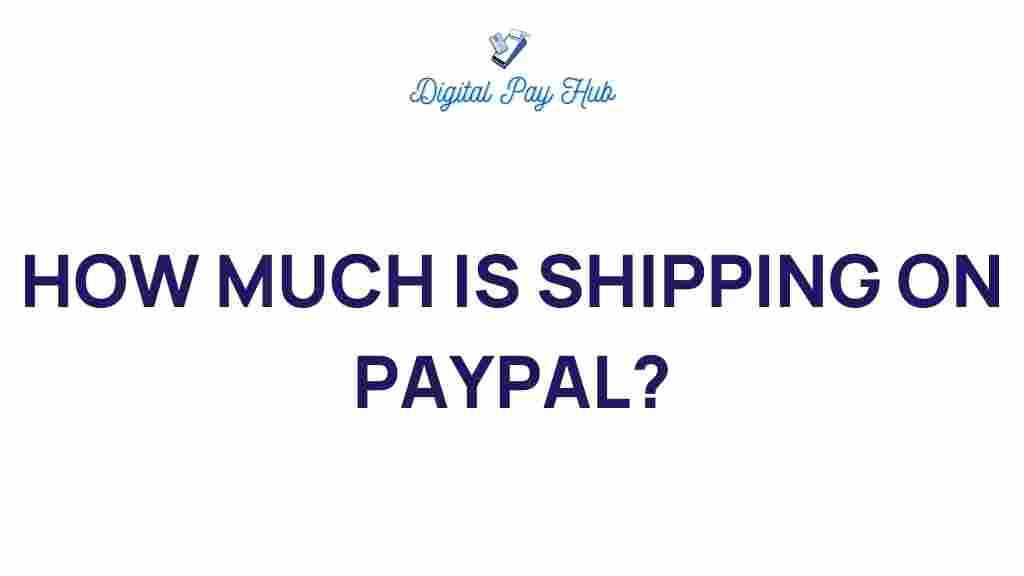Unveiling PayPal Shipping Costs: What You Need to Know
In the world of e-commerce, managing shipping costs is crucial for the success of your online business. One of the most popular platforms for online payments is PayPal, which offers various shipping options that can significantly impact your bottom line. Understanding PayPal shipping costs can help you streamline your operations and maximize your profits.
This article will cover everything you need to know about PayPal shipping, including how to calculate shipping costs, the implications of PayPal fees, and tips for optimizing your shipping strategy. Whether you’re an established seller or just starting in the e-commerce space, this guide will provide valuable insights.
The Basics of PayPal Shipping
When you sell products online, shipping is one of the most significant factors affecting customer satisfaction. With PayPal, you can manage your shipping needs directly from the platform. Here are some key points to consider:
- Integration with E-commerce Platforms: PayPal integrates seamlessly with various e-commerce platforms, allowing you to manage payments and shipping in one place.
- Shipping Calculator: PayPal provides a shipping calculator that helps you determine shipping costs based on weight, dimensions, and destination.
- Digital Wallets: PayPal is one of the most trusted digital wallets, providing buyers with peace of mind through its buyer protection program.
Understanding Shipping Costs
Shipping costs can vary widely based on several factors:
- Weight and Dimensions: Heavier and larger packages generally incur higher shipping fees.
- Shipping Method: Different carriers (like USPS, FedEx, or UPS) offer various rates depending on the speed and type of service (e.g., standard, express).
- Destination: Shipping to remote areas can often cost more than shipping to urban centers.
When using PayPal, it’s essential to factor in these aspects when calculating your shipping costs.
How to Calculate PayPal Shipping Costs
Calculating shipping costs through PayPal is straightforward. Follow these steps:
- Log into Your PayPal Account: Start by logging into your PayPal account.
- Go to the ‘Shipping’ Section: Navigate to the shipping settings in your account profile.
- Enter Package Details: Input the weight, dimensions, and destination of your package in the shipping calculator.
- Choose a Shipping Carrier: Select the carrier you wish to use and review the shipping options.
- Review Costs: PayPal will display the shipping costs based on your inputs.
This shipping calculator can save you time and help you avoid unexpected shipping costs.
PayPal Fees and Transaction Costs
When selling online, you must be aware of the PayPal fees that apply to each transaction. Here’s a breakdown:
- Transaction Fees: PayPal typically charges a percentage of the transaction amount plus a fixed fee per transaction. This can vary based on the country and the type of transaction.
- Currency Conversion Fees: If you sell internationally, be mindful of currency conversion fees that PayPal may apply.
- Shipping Label Fees: If you purchase shipping labels directly through PayPal, additional fees may apply.
These fees can add up, so it’s essential to factor them into your pricing strategy.
Optimizing Your Shipping Strategy
To enhance your e-commerce operations, consider the following tips:
- Offer Flat Rate Shipping: This can simplify costs for customers and can often be more appealing than variable rates.
- Free Shipping Thresholds: Consider implementing a free shipping threshold to encourage larger orders.
- Use PayPal’s Shipping Tools: Utilize PayPal’s shipping tools to streamline your shipping process and minimize errors.
- Compare Rates: Regularly compare rates from different carriers to ensure you’re getting the best deal.
Troubleshooting PayPal Shipping Issues
Even with all the tools PayPal offers, you may encounter shipping-related issues. Here are some common problems and how to resolve them:
- Incorrect Shipping Costs: If the shipping calculator isn’t displaying the correct costs, double-check the weight and dimensions of your package.
- Label Printing Issues: Ensure your printer settings are correct if you’re having trouble printing shipping labels directly from PayPal.
- Shipping Notifications: If your customers are not receiving shipping notifications, ensure your email settings are configured correctly in your PayPal account.
By staying vigilant and addressing these issues promptly, you can maintain a smooth shipping process.
Buyer Protection with PayPal
One of the significant advantages of using PayPal for online payments is its robust buyer protection policy. This policy helps protect customers against fraud and ensures that they receive their purchased items. Key aspects of buyer protection include:
- Eligibility: Buyers are eligible for protection if they have a confirmed delivery address and if they report a problem within 180 days of the transaction.
- Refunds: If a buyer doesn’t receive their item or if it’s significantly different from the description, they can file a dispute and potentially receive a refund.
As a seller, understanding buyer protection can help you enhance customer trust and satisfaction.
Conclusion
Understanding PayPal shipping costs is essential for any e-commerce business looking to thrive in the competitive online marketplace. By calculating shipping costs accurately, being aware of PayPal fees, and leveraging buyer protection, you can create a seamless shopping experience for your customers.
To optimize your shipping strategy, consider the tips outlined in this article, and don’t hesitate to use PayPal’s tools to streamline your operations. If you’re looking for more resources on e-commerce best practices, check out this comprehensive guide.
By effectively managing your shipping costs, you can enhance your profitability and ensure customer satisfaction in your online business.
This article is in the category Payments and created by DigitalPayHub Team
